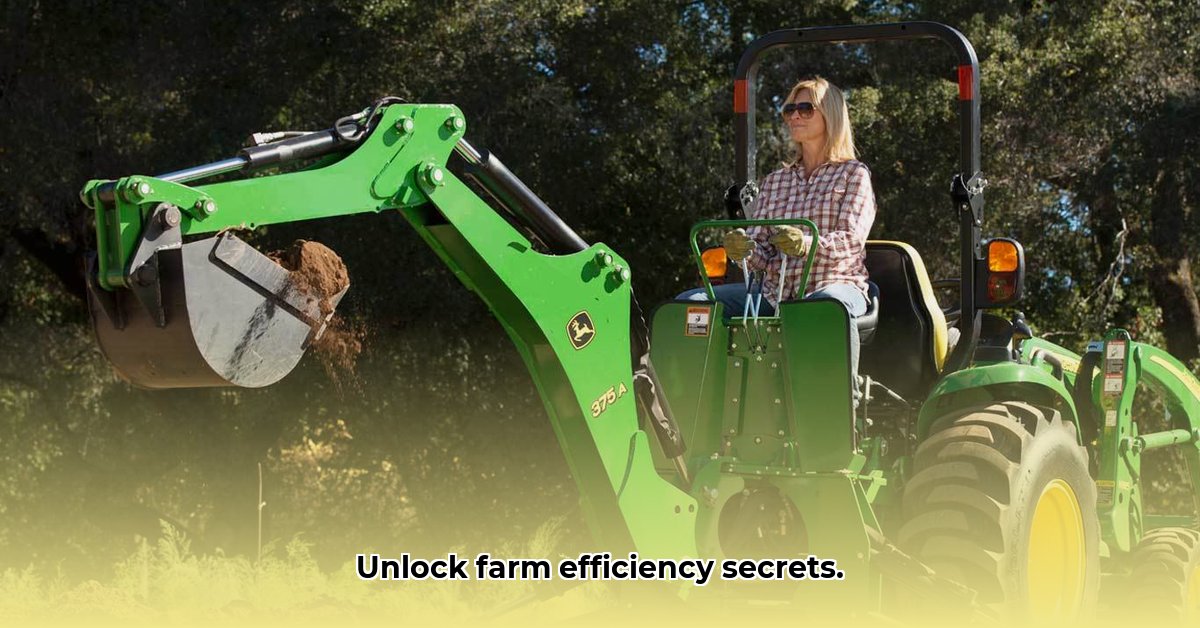
John Deere Backhoes: A Deep Dive into Efficiency and Sustainability
John Deere backhoes offer farmers powerful tools for various tasks, from digging post holes to moving materials. But are they the right investment for your farm, and how do they stack up in terms of sustainability? This article examines the strengths and weaknesses of John Deere backhoes, considering both efficiency and environmental impact. We'll explore how farmers, John Deere, and regulatory bodies can work together to promote sustainable agricultural practices. For more information on John Deere tractor attachments, check out this helpful resource: John Deere Attachments.
Understanding John Deere Backhoe Models for Modern Farming
John Deere offers a range of backhoe models catering to diverse farm sizes and needs. Larger models like the 485 and 595, with their impressive lifting capacity and 180-degree bucket swing, are ideal for large-scale operations. Smaller models such as the 260B and 270B provide enhanced maneuverability, making them suitable for smaller farms and confined spaces. Choosing the right model depends on your specific needs and the scale of your operations. Consider factors like land size, typical workload, and terrain when making your decision.
Assessing the Pros and Cons: A Balanced Perspective
John Deere backhoes boast versatility, handling a wide range of tasks. Their robust construction contributes to longevity. However, a significant gap exists in readily available data regarding their long-term environmental impact. Further information is needed on fuel consumption, maintenance costs, and the overall lifecycle environmental footprint to allow for a truly comprehensive assessment of their sustainability. This lack of transparency hinders informed decision-making for farmers prioritizing sustainable practices.
The Need for Greater Transparency: A Call for Action
Current marketing materials predominantly highlight the power and capabilities of John Deere backhoes, focusing on lifting capacity and reach. However, critical data on fuel efficiency, emissions, and maintenance frequency remains limited. This lack of transparency prevents accurate comparisons between models and hinders the assessment of their role in sustainable farming. Increased data availability is essential for responsible choices.
Collaborative Strategies for a Sustainable Future
Achieving a sustainable future in agriculture requires a collaborative effort. Farmers, John Deere, and regulatory bodies all have vital roles to play:
| Stakeholder | Short-Term Actions | Long-Term Actions |
|---|---|---|
| John Deere | Publicly release comprehensive data on fuel efficiency, emissions, and maintenance needs. | Invest in R&D for more fuel-efficient and potentially electric backhoe models; offer lifecycle cost analyses. |
| Farmers | Carefully assess individual needs, compare models, and prioritize long-term cost-effectiveness. | Prioritize models with better sustainability ratings; explore leasing options to reduce capital investment. |
| Regulatory Bodies | Implement stricter emissions regulations and environmental impact assessments for farm equipment. | Establish financial incentives to promote the adoption of sustainable machinery. |
Addressing Key Challenges: Cost, Fuel Consumption, and Soil Compaction
The initial cost of John Deere backhoes can be substantial, presenting a significant barrier, particularly for smaller farms. Fuel dependence also raises sustainability concerns. Moreover, soil compaction, a potential negative consequence of heavy machinery use, can impact soil health and crop yields. Addressing these challenges requires joint efforts from manufacturers, farmers, and policymakers.
Calculating John Deere Backhoe Fuel Efficiency and Maintenance Costs: A Practical Guide
Accurately assessing the total cost of ownership (TCO) necessitates a comprehensive approach, distinguishing between fixed and variable costs.
Deconstructing Ownership Costs
Fixed costs, independent of usage, include depreciation, interest (if financed), taxes, insurance, and storage. Depreciation, for example, can be calculated using the straight-line method: (Initial cost – Salvage value) / Useful life.
Calculating Operating Costs
Variable costs vary with usage. These include:
- Fuel Consumption: Track fuel usage over a defined period (e.g., monthly) and calculate gallons per hour (GPH) to determine the hourly fuel cost.
- Maintenance and Repairs: Maintain detailed records of all maintenance and repair expenses, averaging them annually.
- Labor Costs: Include operator wages, if applicable.
Fuel Efficiency Calculation
Fuel efficiency (GPH) is calculated by dividing the total gallons of fuel consumed by operating hours. For example, 10 gallons used in 4 hours equals 2.5 GPH. This rate will vary based on factors such as terrain and operating technique.
Maintenance Cost Calculation
Track and total all maintenance and repair expenses annually to establish a baseline for budgeting. This helps anticipate and plan for expenses. Regular preventive maintenance is crucial for minimizing unexpected repair costs.
Comprehensive Cost Analysis
Add annual ownership costs and annual operating costs to obtain the total annual cost of owning and operating your John Deere backhoe.
Boosting Efficiency: Practical Tips
- Regular maintenance is vital for maximizing fuel efficiency and minimizing repairs.
- Proper operating techniques significantly impact fuel consumption.
- Explore telematics systems for fuel usage tracking and performance monitoring.
- Compare prices for fuel and maintenance services.
Key Takeaways:
- Accurate TCO estimation requires detailed cost tracking.
- Differentiate between fixed and variable costs for better financial planning.
- Factors like economic life, salvage value, interest rates, and regional repair costs influence long-term expenses.
- Simplified calculations often underestimate true costs.
- Regular maintenance is essential for minimizing unforeseen repair expenses.
- Fuel efficiency varies depending on operating techniques and the backhoe’s condition.
By embracing transparency and collaboration, farmers can make informed decisions about sustainable machinery choices, paving the way for a more environmentally conscious and economically viable future in agriculture.